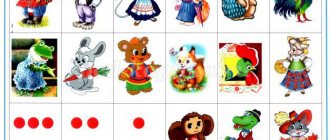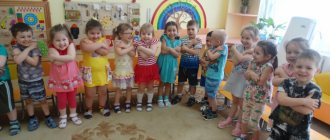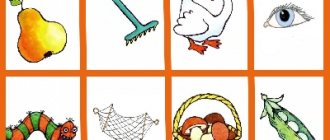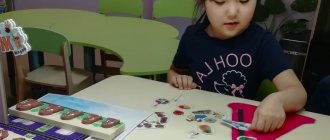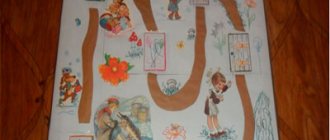SOUND SYMBOLS
Welcome! Speech therapy site "Chatterbox" - a site for speech therapists and caring parents!Everyone knows that preschoolers should learn through play. Learning to read is no exception. Games with sound symbols can help a child master such complex material as sounds and letters.
A sound symbol is a graphic representation of a sound that displays the features of its articulation. Sound symbols are depicted on cardboard cards approximately 10 x 10 cm.
It is recommended to study sounds in the following sequence: “a”, “u”, “o”, “i”, “e”, “s”. Do not move on to learning the next sound until the previous one has been mastered.
>>> see about sounds and letters in the “cheat sheet for parents”
Progress of the lesson:
- show the child a sound symbol and name the sound, clearly articulating: the child should clearly see your lips;
- relate the symbol to the actions of people or animals (the girl cries “ah-ah-ah”, the locomotive hums “oo-oo-oo”, the girl groans “oo-oo-oh”, the horse screams “ee-ee-ee”)
- pronounce the sound with your child in front of the mirror and draw the child’s attention to the movement of the lips (when we pronounce the sound “a” - the mouth is wide open; when we pronounce “o” - the lips look like an oval; when pronouncing “u” - the lips are folded in a tube; when pronouncing “and” - lips stretched into a smile...)
After the child has mastered these sounds, you can move on to the tasks:
- catch the sound The adult pronounces vowel sounds, and the child must clap his hands when he hears the given sound.
- attentive baby The adult names the sound, and the child must show the corresponding symbol.
- choir singer We sing the given sound with different intonations.
- broken TV You need to make a TV screen with a cut out window out of a cardboard box. Explain to the child that the sound on the TV has broken and therefore it is impossible to hear what the announcer is saying (the adult silently articulates vowel sounds in the TV window). The child must guess what sound is being pronounced. Then you can switch roles.
- sound songs Invite your child to compose sound songs like “a-o” (children scream in the forest), “o-a” (a child cries), “ee-a” (a donkey screams), “o-o” (we are surprised). First, the child determines the first sound in the song, singing it drawn out, then the second. Then the child, with the help of an adult, lays out this song from sound symbols and reads the compiled diagram.
- who's first Show your child a picture of an object that begins with the vowel "a", "u", "o" or "i". The child must clearly name what is drawn in the picture, emphasizing the first sound in his voice (for example, “oo-oo-oo-duck”). The child must then choose the appropriate symbol.
- echo The goal of the game is to reinforce clear pronunciation of vowel sounds. The adult pronounces a series of sounds (sound combinations), and the children (echo) repeat what they heard, for example: [a][u], [i][o], [i]o][e], [u][a ][s], [y][a], [s][th], [e][th], [a][o].
As mentioned above, teaching a preschooler to read should take place through play. Phonemic tales are a continuation of games with sound symbols. Phonemic stories help reinforce a child's knowledge of sounds, as well as introduce him to letters. Phonemic tales help a child learn to separate the concepts of “sound” and “letter”.
>>> see more about phonemic tales
>>> rules for conducting classes >>> speech gymnastics >>> fine motor skills >>> word formation >>> auditory attention >>> logorhythmics >>> mnemonics
Special symbols in preparing 4-year-old children for learning to read and write, Tkachenko T.A., 2000
Special symbols in preparing 4-year-old children for learning to read and write, T.A. Tkachenko, 2000. The manual by the famous Moscow speech therapist-practitioner, author of 10 books, presents theoretical principles and practical recommendations, as well as a system of training for 4-year-old children their skills of sound analysis and synthesis, without which mastering literacy is impossible. The use of original author's symbols makes it possible to most effectively prepare children with and without problems in speech development to master reading and writing. The manual contains entertaining games and exercises, as well as lesson notes that are recommended to be carried out with preschoolers in children's educational institutions and with their families. Addressed to teachers of mass and correctional groups, defectologists and speech therapists, students of pedagogical universities and colleges, as well as tutors and parents of preschool children. Introduction. The main task of any preschool institution is to prepare the child for school, including the acquisition of written language. One of the indicators of a child’s readiness to read and write is clean, clear, correct speech in all respects. At the age of 4, many children correctly pronounce all the sounds of their native language without the intervention of a speech therapist, and it would seem that there are no obstacles to their acquisition of literacy. At the same time, in the process of teaching such preschoolers to read and write, adults may encounter certain difficulties. Using this manual will help you overcome them, turn learning sound analysis into an interesting and at the same time effective game, and answer many theoretical and practical questions for teachers and parents. If a 4-year-old child has pronunciation defects or more complex speech disorders (dysarthria, rhinolalia, alalia, general speech underdevelopment), then the process of teaching literacy to such a preschooler is seriously complicated. Content. Introduction. Information that is useful to know for teachers and parents who are preparing to teach a preschooler to read and write. The role of symbols in preparing preschoolers for literacy. Planning and conducting classes to prepare for learning to read and write in mass groups of children's educational institutions. Conducting classes on the formation of the phonetic side of speech in speech therapy groups. Lesson notes. Bibliography. Application. Visual material (images of special characters).
Download the e-book for free in a convenient format, watch and read: - fileskachat.com, fast and free download.
Below you can buy this book at the best price with a discount with delivery throughout Russia. Buy this book
How to open a file
Copyright holders
- pdf - Yandex.Disk. - djvu - Yandex.Disk.
Publication date: 07/02/2019 09:07 UTC
Tkachenko :: 2000 :: child :: preparation :: literacy
See also textbooks, books and educational materials:
- Teaching literacy in kindergarten, Starzhinskaya N.S., 2000
- Preparation for teaching literacy to children 5-6 years old, scenarios of educational activities, Zhurova L.E., 2013
- Syllable structure of a word, Correction of violations, Speech therapy notebook, Tkachenko TA
- Education with sound, music lessons, Rokityanskaya T.A., 2005
The following textbooks and books:
- Preparing children for school, a manual for parents, Bolsun N.V., Revtovich N.M., 2007
- Educational moments, how to love a child, leave me to the children, Korczak Y., Stotskoy L., 2017
- Classes with children 2-3 years old, social development, the world around us, Vinnikova G.I.
- Preparing disabled children for family and adult life, a manual for parents and specialists, Yarskaya-Smirnova E.R., 2007
Previous articles:
- The main book about education, how great it is to be with children, Surkova L., 2018
- Children from heaven, parenting lessons, how to develop a spirit of cooperation, responsiveness and self-confidence in a child, Gray D., 2013
- Implementation of a systematic approach in youth education, monograph, Ananyin G.E., Bayborodova L.V., 2012
- Staging sounds.
<< Previous articleNext article >>
How to teach a child to speak the sound [F]
In the case of dyslalia, parents can try to correct the child’s disorder on their own. To do this, they just need to follow the recommendations of the speech therapist.
What to do if the child is 4 years old and does not speak
Classes are held every day for 10–15 minutes. The absence of hissing sounds [Ш], [Ж], [Ш], [Ч] before the age of four is considered the norm, since the muscles of the articulatory apparatus are not fully developed in a preschooler.
Note! In order to understand how to teach a child to say the letter Z, you need to understand the features of pronunciation.
To make this sound, the lips are slightly rounded, moved forward, the tongue takes the shape of a “cup” and is located behind the teeth. The vocal cords are actively working and the sound [Zh] is produced.
It is better to place the sound [Zh] from the correct [Sh], since the whole difference between these two sounds is in the work of the voice.
Approximate articulation gymnastics for children for the sound [Ш]:
- The tongue is placed on the lower lip and lightly bitten with the lips.
- Opening your mouth wide, lift the tip of your tongue onto the alveoli of your upper teeth. To make it easier, you can use a small piece of candy.
- Press the wide part of your tongue against the roof of your mouth and hold for 5 seconds.
- Use the tip of your tongue to lick your upper lip.
The baby must perform each exercise in front of the mirror to control himself. The parent controls the immobility of the jaw. It can take a year to develop the correct movements, so an adult is interested in frequent training - this will reduce the preparation time.
Sound production techniques [Ш]
A simple way to produce isolated sound is mechanical. Using a spatula, lift the tongue to the alveoli of the upper teeth. At this time, the child says “SA-SA-SA.” After the tongue has been raised, “SHA-SHA-SHA” will be heard.
Important! Manipulations should not cause discomfort.
Gradually, the mechanical assistance is removed and the correct sound is practiced.
The learning process can be combined with games
It will take a long time to teach a child to pronounce a sound correctly. Only straight syllables are used as material: SHA, SHO, SHI, SHE, SHU. As soon as he learns to pronounce them correctly, they move on to reverse syllables, then to words.
Speech therapy manual for children
Developing a sound culture is a complex matter. Children quickly get used to speaking incorrectly and are difficult to retrain. Many books are published for the educational process.
The speech therapy manual for children, edited by Bogomolova, contains all the necessary material for automating all speech sounds. Methods of production and important aspects of the work are briefly described. Such information will be useful not only to speech therapists, but also to parents.
A child needs to be taught to speak correctly from childhood. Otherwise, he will have difficulties with writing, reading and counting. Improper pronunciation can cause complexes.
Sound culture is the key to confidence in adulthood. Therefore, she needs to pay a lot of attention.
Features of the book by Fomicheva M.F.
In speech therapy, various speech defects are distinguished. Dyslalia is diagnosed for those children who cannot pronounce one or more sounds. To correct such a violation, step-by-step work is required.
Only consistent and methodical work will help the child cope with the disorder.
In the book by Fomicheva M.F. “Education of Correct Sound Pronunciation in Children” all components of the correction process are considered. The first part provides brief information about how children’s speech develops normally and what exercises can be used to identify deviations.
The next part provides a brief description of speech defects - sigmatisms, rhotacisms, cappacisms, lambacisms. There is information about other childhood disorders - alalia, stuttering, dysarthria, delayed speech development.
Important! Correct diagnosis allows you to effectively organize work with the child.
In order for children to be able to pronounce a certain sound, they must undergo appropriate training. Fomicheva in her book indicated sets of exercises that will help prepare their articulatory apparatus.
This stage is available to both educators and parents. The speech therapist conducts a preliminary examination, which will provide a complete description of the disorder.
The next stage is sound production. They switch to it only after good performance of articulatory gymnastics. The specialist uses special techniques that allow you to create an isolated sound. The third stage is the automation of sound in syllables, words and sentences.
The fourth stage is an introduction to independent speech.
It is necessary to follow the sequence of stages, otherwise it will not be possible to achieve results
The book contains activities for each age group - first and second junior, middle, senior and preparatory. The work of educators, speech therapists and parents will help educate children in correct sound pronunciation.
